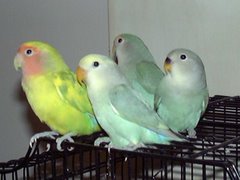So, you want to breed your lovebirds. Breeding lovebirds is not a daunting task. As you know very well that lovebirds are the smallest parrots in the world, breeding the lovebirds require little patience and dedication.
Providing healthy diet comprising of greens will improve their breeding efficiency. Breeding lovebirds require more animal proteins in their diet. In the wild, they will eat the worms in the green plants. As a lovebird breeder, you can provide ant eggs, various flies and insect that normally found on green leaves, crickets, maggots and mealworms before laying eggs.
Some of the owners are feeding their lovebirds only with grains and pellets, which made their lovebirds poor breeders. The breeding area should be about 60 degrees F with 60% humidity.
Nest Boxes
Nest boxes used for parakeets are more than sufficient. You can easily get these standard parakeet boxes from departmental stores. Don't forget to provide nesting materials such as pine shaving, willow branches, palm fronds, and newspaper in the nest box.
The first egg can be obtained after 10 days of mating. If your lovebird is a determined one, it will build nest 4 to 5 days prior to egg laying. The lovebird will lay 4-6 eggs within 10 days from the start of first egg. You can candle the eggs after 6-7 days to determine its fertility. The fertile eggs will show dark spot surrounded by blood vessels once you hold the eggs gently near a bright light. The eggs will hatch out within 21 to 26 days of brooding.
Maintaining Baby Lovebirds
Maintenance of hatched chicks is an important step in breeding lovebirds. Once the first chick comes out of the egg, provide the parents with lot of good foods. The breeding diet includes fruits, greens, egg, corn and other preferred foods. Food and fresh water should be made available at all the times in the cage.
Lovebird babies should be watched carefully for its health as well as the parental care of the adult ones. Periodically check the lovebird's babies for their feeding behavior. Sometimes you need to handfed a baby lovebird.
Weaning of Lovebird Babies
Weaning should be performed for further breeding of the lovebirds. The baby birds should be separated from the parents after 10-14 days old. But they do require hand feeding. If you haven't weaned them, the parents will wean the young ones after 5 to 6 weeks.
The father helps the baby to learn how to eat the regular foods. If you want to hand feed your baby chicks, I will help you a lot by discussing that topic somewhere else in this blog.
Your lovebirds baby should be provided with varied feedstuffs for its well being. Breeding of lovebirds not only stops at the level of hatching but it will long last till the baby lovebird matures. Hence millets, pellets, seed, fresh fruits and vegetables (small pieces) and soft food play an important role for early maturity for the young one.








 Free Ads For Bloggers
Free Ads For Bloggers

